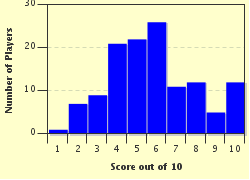Quiz Answer Key and Fun Facts
1. An extension built onto England's gracious old Poole Methodist Church in High Street, Dorset, took out which dubious architectural distinction in 2016?
2. The Taunton Flag, one of the first used in British North America just prior to the 1776 Revolution, features which three words?
3. Which creatures in ancient Egypt were known as "Thunderers of the Nile"?
4. For which agricultural purpose was the old Saxon structure known as a "boo" utilised?
5. What was the purpose of the announcement of marriage banns?
6. Document 12-571-3570 was a hoax regarding the testing of which so called functions aboard space shuttle missions?
7. In spite of stopping half way through the race, Australian Bobby Pearce won the gold medal at the 1928 Olympics for sculling. Why did he stop?
8. When King George VI of the UK was visiting a very segregated South Africa in 1947 and saw the motto "Ex unitate veres" (From unity, strength) on the royal train, what did he say?
9. A "hti" adorns the top of almost all pagodas in Myanmar. What is the English translation of this word?
10. We all know that a busy beaver is a very industrious person - but what else is it?
Source: Author
Creedy
This quiz was reviewed by FunTrivia editor
agony before going online.
Any errors found in FunTrivia content are routinely corrected through our feedback system.


